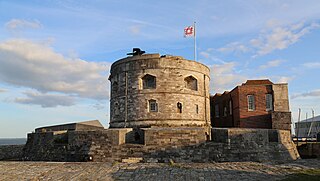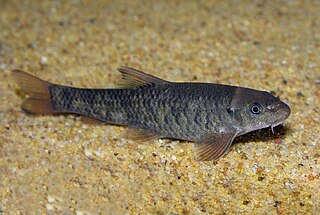A dace is a small fish that can be one of many different species. The unmodified name is usually a reference to the common dace. This, like most fish called "daces", belongs to the family Cyprinidae, mostly in subfamily Leuciscinae.

The Device Forts, also known as Henrician castles and blockhouses, were a series of artillery fortifications built to defend the coast of England and Wales by Henry VIII. Traditionally, the Crown had left coastal defences in the hands of local lords and communities but the threat of French and Spanish invasion led the King to issue an order, called a "device", for a major programme of work between 1539 and 1547. The fortifications ranged from large stone castles positioned to protect the Downs anchorage in Kent, to small blockhouses overlooking the entrance to Milford Haven in Pembrokeshire, and earthwork bulwarks along the Essex coast. Some forts operated independently, others were designed to be mutually reinforcing. The Device programme was hugely expensive, costing a total of £376,000 ; much of this was raised from the proceeds of the Dissolution of the Monasteries a few years before.

Hurst Castle is an artillery fort established by Henry VIII on the Hurst Spit in Hampshire, England, between 1541 and 1544. It formed part of the king's Device Forts coastal protection programme against invasion from France and the Holy Roman Empire, and defended the western entrance to the Solent waterway. The early castle had a central keep and three bastions, and in 1547 was equipped with 26 guns. It was expensive to operate due to its size, but it formed one of the most powerful forts along the coast. During the English Civil War of the 1640s, Hurst was held by Parliament and was used briefly to detain King Charles I before his execution in 1649. It continued in use during the 18th century but fell into disrepair, the spit being frequented by smugglers.

Calshot Castle is an artillery fort constructed by Henry VIII on the Calshot Spit, Hampshire, England, between 1539 and 1540. It formed part of the King's Device programme to protect against invasion from France and the Holy Roman Empire and defend Southampton Water as it met the Solent. The castle had a keep at its centre, surrounded by a curtain wall and a moat. Initially heavily armed, it had a garrison of 16 men and as many as 36 artillery guns. The castle continued in use for many years, surviving the English Civil War intact and being extensively modernised in the 1770s. During the 19th century, Calshot Castle was used by the coastguard as a base for combating smuggling. In 1894, however, fresh fears of a French invasion led to it being brought back into use as an artillery fort: a large coastal battery was constructed alongside the older castle and a boom built across Southampton Water, controlled from the castle.
Tariqilabeo is a genus of fish in the family Cyprinidae native to Asia.
Peter Coad is a software entrepreneur and author of books on programming. He is notable for his role in defining what have come to be known as the UML colors, a color-coded notation chiefly useful for adding breadth and depth to a design, using four major archetypes.
Paddy Coad was an Irish football player and manager. He played as a forward for Waterford, Glenavon, Shamrock Rovers and Ireland. Although known, primarily, as a maker of goals, Coad scored 126 goals in the League of Ireland and a further 41 in the FAI Cup. In 1946–47, he was top goalscorer in the League of Ireland. As a player manager, he also guided Shamrock Rovers to three League of Ireland titles and two FAI Cups, before he returned to Waterford and guided them to their first league title in 1966. He was appointed manager of Limerick in September 1967.

Doyle Merwin Coad is an American retired minister and politician from Iowa. A member of the Democratic Party, he served as a member of the United States House of Representatives for three terms from 1957 to 1963. His election snapped the Republican Party's fourteen-year hold on every U.S. House seat from Iowa.

Acanthobrama is a genus of ray-finned fish in the family Cyprinidae found mostly in the Near East.

Alburnoides is a genus of cyprinid fishes native to Europe and Asia. Many species are known as riffle minnows or spirlins.

Garra is a genus of fish in the family Cyprinidae. These fish are one example of the "log suckers", sucker-mouthed barbs and other cyprinids commonly kept in aquaria to keep down algae. The doctor fish of Anatolia and the Middle East belongs in this genus. The majority of the more than 160 species of garras are native to Asia, but about one-fifth of the species are from Africa.
Cromptodon is an extinct genus of cynodonts from the Triassic of Cerro Bayo de Portrerillos, Cerro de las Cabras Formation, Argentina, South America. It is known only from PVL 3858, a mandible.

Carasobarbus, the himris, is a small genus of ray-finned fishes in the family Cyprinidae. Its species are found in rivers, streams, lakes and ponds in Western Asia and Northwest Africa. C. canis can reach 66 cm (26 in) in total length, but most other species are up to around half or one-quarter of that size.

Michael Coad is a former professional Australian rules footballer who played with Australian Football League (AFL) club Gold Coast.

Allochrocebus is a primate genus including the terrestrial guenons: the L'Hoest's monkey, the Preuss's monkey, and the sun-tailed monkey.

Metagonimus yokogawai, or the Yokogawa fluke, is a species of a trematode, or fluke worm, in the family Heterophyidae.
Alburnoides idignensis, is a fish species of the family Cyprinidae endemic to Iran. It can be differentiated from its cogenerates by differences in fin ray and vertebral counts, together with other morphological characters. The specific name is derived from the Sumerian name for the River Tigris, "Idigna".
Emma Dent Coad is a British architectural historian and politician who served as Member of Parliament (MP) for Kensington from 2017 to 2019. A former member of the Labour Party, she has been a member of Kensington and Chelsea London Borough Council since 2006. She resigned her Labour membership on 27 April 2023, but remains on the local council as an independent.
Matthew Coad is a New Zealand sprinter. He competed in the men's 200 metres at the 1996 Summer Olympics. Coad holds a 200m best of 20.61 (+1.8m/s), which is currently the fifth fastest 200m time in New Zealand history, as well as a 100m best of 10.44 (+0.9m/s).

The big-scaled redfin, also known as the Japanese dace and ugui, is a medium-sized Asian fish. First described by Albert Günther in 1877 as Leuciscus hakonensis, it was the type specimen of the genus Tribolodon, having been described again as Tribolodon punctatum by Henri Émile Sauvage when he established that genus in 1883. It is the most widely distributed of the Pseudaspius species, found over much of the Sea of Japan. It is known to carry a number of parasites, including the trematode species Centrocestus armatus, and the copepod species Ergasilus fidiformis, which is carried in the fish's gills.


















